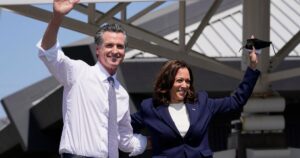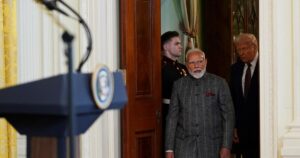Image Source: Getty Images
The euphoria in Pakistan following its recent trade deal with the United States (US)—on seemingly more favourable terms than those accorded to arch-rival India and other regional competitors—has given way to the sobering realisation that the deal, in fact, doesn’t do much for Pakistan. The initial flush of excitement over US President Donald Trump’s post on his social media handle was fuelled not only by his announcement that the US will help develop Pakistan’s “massive oil reserves” but also by his comment to India to buy the oil produced in Pakistan.
Pakistan’s schadenfreude peaked after Trump imposed an additional 25 percent penalty on India for buying Russian oil, and on the same day, invited Pakistan’s Army Chief, Field Marshal Asim Munir, for a second visit to the US. However, even though the US has issued the Executive Order (EO) detailing the modified reciprocal tariff rates on 31 July 2025, there is still little clarity on what exactly the Pakistani negotiators signed on with the US. The information seems to be seeping out in dribbles. According to the information available in the public domain, Pakistan has agreed to zero percent tariffs on over 4,000 items it will import from the US in exchange for a 19 percent reciprocal tariff on Pakistani exports, and US investments in Pakistan’s oil, mineral, and crypto sector.
In addition to Trump’s proclivity to use superlatives for even the most mundane and inane things, no one was quite sure where the bit about Pakistan possessing huge oil reserves came from.
Eyebrows and doubts alike have certainly been raised over the issue of Pakistan’s ‘massive oil reserves’. In addition to Trump’s proclivity to use superlatives for even the most mundane and inane things, no one was quite sure where the bit about Pakistan possessing huge oil reserves came from. Either Trump used a negotiating tactic—pretending to believe Pakistan’s claims of holding the world’s fourth-largest oil and gas reserves to secure better terms for the US—or he has actually been convinced that Pakistan is the next big story in oil and minerals, choosing to back them despite contrary estimates from independent analysts, including the US Energy Information Administration (EIA). Although no one knows when or where Pakistan’s oil reserves will come from, the Pakistanis have been forced to start buying oil from the US. It hardly resembles the ‘game changer’ deal that sycophants of the hybrid, military-dominated regime in Islamabad have labelled it to be.
Pakistan has had a long history of selling the proverbial snake oil to tout themselves and appear more attractive as a business proposition than it actually is. Exaggerated and often unsubstantiated claims have frequently been made by Pakistani leaders and military officials—ostensibly to reassure domestic audiences about forthcoming economic relief, while also attempting to attract the interest of foreign investors in an otherwise lacklustre economic environment. In 1976, Former Pakistani President Zulfikar Ali Bhutto announced a giant oil discovery that would make Pakistan self-sufficient in oil in three years. Earlier in 1973, Pakistanis were told that the potential oil reserves in the Indus basin were to the tune of 40-45 billion barrels. 50 years later, oil remains Pakistan’s single largest import. Fast forward to 2006, Pakistan were again led up the garden path when they were told lignite deposits in the Thar desert in Pakistan would provide the country with enough power for the next century. All the investment made in the coal gasification project came to nought. In the early 2000s, copper became the new oil and was expected to take Pakistan’s economy to the stratosphere. However, the Saindak copper project in Balochistan has yielded only around US$3 billion in over two decades. The Reko Diq project—supposed to change Pakistan’s destiny—is also expected to yield a free cash flow of only US$74 billion over 37 years, i.e., US$2 billion a year. This is barely the kind of money that changes the destiny of a country with a populace of 250 million people, and is anticipated to rise much over the 400 million mark in 37 years. There are already murmurs that the lead company in Reko Diq is seeking an exit by offloading a significant portion of its stake to interested investors.
Exaggerated and often unsubstantiated claims have frequently been made by Pakistani leaders and military officials—ostensibly to reassure domestic audiences about forthcoming economic relief, while also attempting to attract the interest of foreign investors in an otherwise lacklustre economic environment.
In 2015, the then Prime Minister (PM) Nawaz Sharif declared that Pakistan was all set to break the proverbial ‘begging bowl’ after the discovery of huge iron ore and copper deposits in Chiniot in Punjab. The PM and his brother, Shehbaz Sharif, who was then the Chief Minister of Punjab, claimed that in search of iron ore, they had found gold and copper in Chiniot. The same man – allegedly the greatest Pakistani nuclear scientist in the world, Dr Samar Mubarakmand – who had led the country up the garden path on the promise of Thar Coal gasification, was also behind the pipe dreams of gold and copper in Chiniot. Chiniot was billed as being even bigger than Reko Diq. However, within weeks, the bubble burst. As the economic situation tightens, the desperation for divine intervention—or a lottery-like stroke of luck—only grows stronger.
In 2019, Imran Khan declared that Pakistan was on the verge of striking liquid gold (oil) off the shore of Karachi and would soon be catapulted into a completely different league. Nonetheless, within days, all the dreams came crashing down after no oil was discovered. One of Imran’s ministers, Faisal Vawda, took the cue from his boss and grandly announced that within weeks, if not days, Pakistan would be flush with so many jobs that people from abroad would line up to seek jobs in Pakistan. Six years later, independent economists have estimated a historic level of unemployment in the country of over 22 percent. After Imran Khan was ousted from office in 2022, his successors faced a desperate economic situation, staring at bankruptcy and default. This was the ideal time for some grandstanding by the very people who brought the economy to the brink of collapse. The then Finance Minister, Ishaq Dar, whose proclivity to blow his own trumpet and abrasiveness had derailed the International Monetary Fund (IMF) programme, defiantly claimed that Pakistan was not insolvent and had assets worth trillions of dollars. Another minister boldly declared that the ‘financial value of Pakistan’s minerals amounted to US$6.1 trillion, surpassing the total net worth of corporate giants such as Apple, Amazon, and Google’.
A year after the US$100 billion investment claim, the Pakistan Army floated yet another story, resurrecting the old myth of Pakistan sitting astride an ocean of oil.
Furthermore, the Army Chief Asim Munir also decided to lift the public mood. Within weeks of the US$6.1trillion claim, Munir, who was then a four-star general, told a gathering of businessmen that he would very soon bring in investments of US$100 billion to Pakistan from the Arab Gulf states. Two years later, he has nothing to show for his tall claims. Meanwhile, he has also been elevated to the rank of Field Marshal. A year after the US$100 billion investment claim, the Pakistan Army floated yet another story, resurrecting the old myth of Pakistan sitting astride an ocean of oil. In September 2024, claims of Pakistan having discovered an oil and gas reserve ‘so large its exploitation could change the country’s destiny’ were once again floated. The boast was that this was the world’s fourth-largest oil reserve.
Although some professionals cautioned fellow Pakistanis against falling for Sheikh Chilli’s dreams, the story of Pakistan possessing ‘massive oil reserves’ was successfully sold to and bought by characters close to the US president. Aside from oil, Pakistan also dangled the carrot of rare earth minerals and cryptocurrency to the Americans. The latter never bothered to ask why—if Pakistan is truly so resource-rich—its ‘all-weather friend’ and ‘Iron Brother’ China, which has poured in substantial investments, has made no serious effort to exploit this supposed huge wealth.
The pipe-dreams of tens of billions of dollars in US investments flooding into Pakistan aside, the prospects of trade are also not going to set the Indus on fire. In fact, some reports suggest that US negotiators used the India card to force the Pakistanis to concede to all their demands. The 19 percent tariff on Pakistan does not offer it any great advantage over competitors such as Egypt, Bangladesh, Sri Lanka or Vietnam. The high cost of production and the economic, political, and security uncertainties and unrest are not going to encourage buyers to line up to enter Pakistan. In any case, the US-Pakistan trade is quite insignificant. The bilateral trade in 2024 was about US$7.6 billion, with Pakistan importing just a little over US$2 billion. Out of Pakistan’s exports of around US$5.5 billion, nearly 80 percent were cotton, textiles, and apparel, and the prospects of these increasing significantly are not at all very bright.
The high cost of production and the economic, political, and security uncertainties and unrest are not going to encourage buyers to line up to enter Pakistan.
While expectations from the trade deal with the US are now more subdued, there is a buzz that the US and Pakistan might once again become strategic allies. Although there is as yet nothing to suggest that the US will reopen defence sales to Pakistan, or that the relationship will go back to what it was in the last century. Supplying weapons at concessional rates is not something that anyone expects from the Trump administration, and Pakistan just does not have the money to pay for US weapon systems and platforms. The other apprehension in Pakistan is that the Trump administration might have diplomatic (Abraham Accords) and strategic (Iran) asks that will make Pakistan baulk. However, for now, there is a sense of satisfaction in Islamabad and even more in Rawalpindi that Pakistan remains on Trump’s right side. There is even more happiness to see Trump burn the relationship with India to the ground. In a country where people live to bring the house of their enemy even if they come under, nothing can be more satisfying than the unravelling of the India-US relationship.
Sushant Sareen is a Senior Fellow at the Observer Research Foundation.













